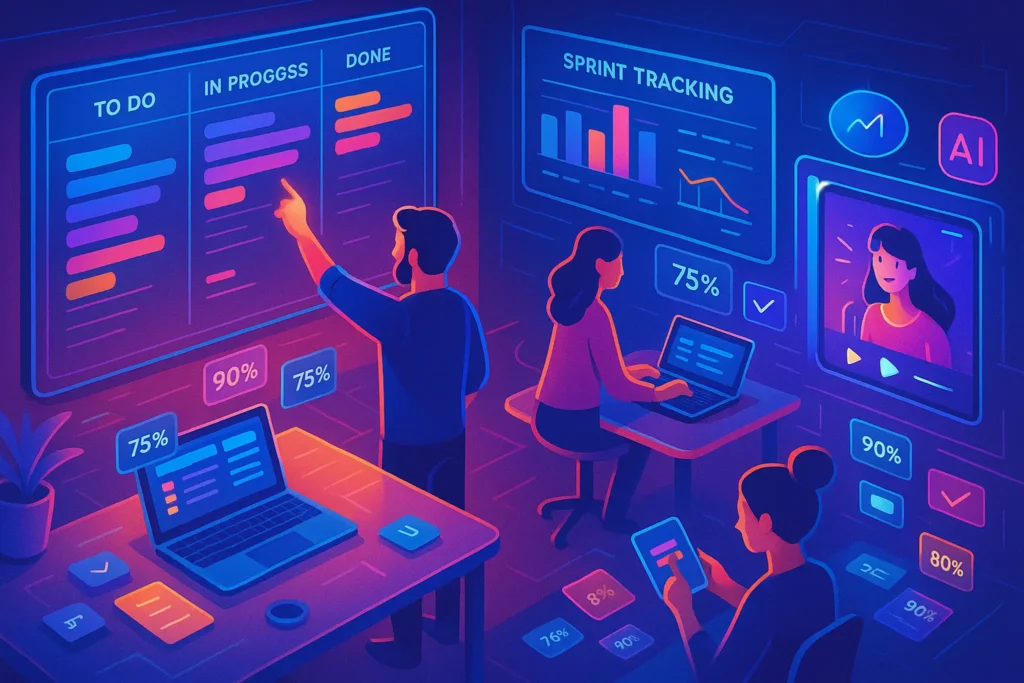🚀 Why Agile is a Game-Changer for Big Projects
Managing large projects — whether building a SaaS platform, producing a global marketing campaign, or rolling out new company infrastructure — is like steering a massive ship. Traditional project management approaches often struggle to keep up with changing priorities, shifting client demands, and unexpected challenges. That’s where Agile methodology shines.
Agile isn’t just for software development. Over the last decade, it has become the go-to framework for managing any complex, collaborative project. Its principles — flexibility, continuous feedback, and iterative progress — help teams avoid common pitfalls like scope creep, bottlenecks, and communication breakdowns.
Imagine coordinating a team spread across multiple time zones, each working on different components of a product launch. Instead of following a rigid, year-long plan, Agile breaks the project into manageable sprints, with progress reviewed and adjusted regularly. This ensures the team can pivot quickly when challenges arise — without derailing the entire timeline.
💬 Think about your current project. If a major requirement changed tomorrow, could your workflow adapt without losing weeks of progress? If not, you’ll want to read on.
🧠 Core Principles of Agile for Large-Scale Projects
While Agile can be implemented in many ways (Scrum, Kanban, Lean, etc.), its core principles remain consistent. Understanding these is critical before diving into tools or processes.
-
Iterative Development (Sprints)
Instead of delivering one massive result at the end, Agile breaks work into short, focused cycles called sprints (often 1–4 weeks). Each sprint produces a usable output — a feature, a campaign asset, or a deliverable — that can be reviewed and refined. This avoids the “big reveal” problem where months of work fail to meet expectations. -
Continuous Feedback
Agile thrives on constant communication and adjustment. Stakeholders and team members regularly review progress, ensuring the project evolves with real-time input. This drastically reduces the gap between what’s being built and what’s actually needed. -
Cross-Functional Teams
Rather than siloed departments, Agile brings together all necessary skills within the project team — design, development, marketing, QA — so decisions are made quickly without waiting for external approvals. -
Transparency & Visibility
Every team member should be able to see the current project status at a glance. Tools like Kanban boards make bottlenecks and progress instantly clear, which is essential when managing dozens of moving parts.
By committing to these principles, large projects become more adaptable and predictable — even in the face of shifting requirements.
📌 For a deeper dive into choosing the right software to manage these workflows, check out The Ultimate Guide to Project Management Software.
📅 Breaking Big Projects into Sprints
One of Agile’s biggest strengths is its sprint-based structure. For large projects, sprints transform overwhelming timelines into actionable segments with clear priorities.
Let’s say you’re leading a global website redesign. Instead of a 9-month grind with endless to-do lists, you could break it into:
-
Sprint 1: Finalize new brand guidelines and homepage design.
-
Sprint 2: Build and test navigation + key landing pages.
-
Sprint 3: Integrate SEO optimizations and content migration.
-
Sprint 4: Launch in phases, starting with high-traffic regions.
Each sprint focuses on high-value deliverables that can be reviewed with stakeholders before moving forward. If priorities shift — for example, adding multilingual support becomes urgent — you can reallocate resources in the next sprint without undoing months of work.
✅ Nerd Tip: Keep sprints short enough to stay agile (2–3 weeks is ideal) but long enough to produce meaningful results.
📌 Pair this approach with the time-blocking strategies from Time Blocking vs Task Batching to make each sprint as productive as possible.
💬 Daily Stand-Ups & Communication Flow
In large-scale projects, communication failures can sink progress faster than technical issues. Agile tackles this head-on with daily stand-up meetings — short, focused sessions (usually 10–15 minutes) where each team member answers three key questions:
-
What did I work on yesterday?
-
What will I work on today?
-
Are there any blockers in my way?
The goal isn’t to micromanage but to maintain visibility across the team. In a multinational product launch, for example, the design team might flag that a key asset is delayed, allowing the marketing team to adjust schedules before it becomes a crisis.
🧠 Why It Works for Big Projects:
Daily stand-ups ensure problems are caught early, prevent duplicated work, and foster a sense of accountability. Even distributed teams benefit, as stand-ups can happen via video calls or async updates in tools like Slack or Microsoft Teams.
📌 If you’re also looking to improve your personal productivity within these team workflows, you might find Best Time Management Apps to Keep You on Track helpful.
🛠 Agile in Practice: Real-World Applications
Theory is great — but Agile shines brightest in real project environments. Let’s break down a couple of examples where Agile kept massive initiatives on track.
Example 1: Software Development for a Global Bank
A banking giant was rolling out a new mobile app across multiple countries. Instead of waiting 18 months for a complete product, they used Agile sprints to release country-specific versions every 4–6 weeks. This allowed them to gather feedback from early markets and implement improvements before the wider rollout — avoiding costly rework.
Example 2: Marketing Campaign for an International Brand
A consumer goods company adopted Agile for its seasonal campaigns. The creative, social, and analytics teams worked in parallel, meeting in daily stand-ups and reviewing campaign performance weekly. They could pivot creative direction mid-campaign based on real-time engagement data, leading to a 35% boost in ROI compared to previous years.
💬 Picture your current project. What’s one element you could deliver earlier in a “mini launch” to gather feedback sooner?
📊 Kanban & Scrum Tools for Large Teams
Agile principles can be applied with nothing more than sticky notes and a whiteboard — but for big projects, digital tools make all the difference.
-
Kanban Boards (e.g., Trello, Jira, Asana)
Visualize your workflow with columns like Backlog, In Progress, and Done. Kanban is ideal for teams that need a clear, continuous flow of work. -
Scrum Management Tools (e.g., ClickUp, Monday.com, Azure DevOps)
Scrum tools structure work into sprints, provide sprint planning boards, and include velocity tracking so you can forecast timelines with more accuracy. -
Hybrid Tools (e.g., Notion, Wrike)
Offer flexibility to combine Kanban, Scrum, and other Agile styles in one platform — great for multi-department projects.
⚖️ Ethics, Challenges & Avoiding Agile Pitfalls
While Agile offers flexibility, it’s not a magic bullet. Here are common challenges and how to address them:
-
Scope Creep
Agile can sometimes encourage “just one more feature” thinking. Counter this by locking sprint goals and treating new requests as backlog items for future sprints. -
Misusing Flexibility
Without discipline, Agile can devolve into chaos. Stick to your core sprint structure and review processes. -
Team Burnout
The pace of Agile can lead to overwork if teams aren’t careful. Balance velocity with sustainable work hours to maintain morale.
Ethically, Agile projects also need to consider transparency with stakeholders — especially if project shifts affect cost, deadlines, or deliverables. Honesty builds trust, even when adjustments are necessary.
🎨 Quick Checklist: “Agile Readiness in 5 Steps”
✅ Define a clear project vision and share it with the whole team.
✅ Break down deliverables into smaller, testable chunks.
✅ Schedule daily stand-ups to maintain communication.
✅ Use a Kanban or Scrum tool for visibility.
✅ Commit to regular sprint reviews and retrospectives.
Mini Comparison Table: Scrum vs Kanban for Big Projects
| Feature | Scrum | Kanban |
|---|---|---|
| Structure | Fixed-length sprints | Continuous flow |
| Best For | Projects with defined phases | Ongoing work and priorities |
| Planning Frequency | Every sprint (1–4 weeks) | As needed |
| Visibility | Sprint boards | Workflow boards |
📬 Want More Proven Agile Project Tips?
Join our free newsletter and get weekly insights on Agile strategies, productivity frameworks, and project management tools—designed for high-performing teams and big projects.
Actionable tips. Zero fluff.
🔐 100% privacy. No spam. Just value-packed insights from NerdChips to help you deliver projects on time, every time.
🧠 Scaling Agile for Large, Multi-Team Projects
One common misconception is that Agile only works for small, fast-moving teams. In reality, there are frameworks specifically designed to scale Agile across dozens or even hundreds of people without losing the adaptability that makes it powerful. The Scaled Agile Framework (SAFe), Large-Scale Scrum (LeSS), and Disciplined Agile Delivery (DAD) are prime examples.
For instance, SAFe introduces layered planning—portfolio, program, and team levels—to coordinate work across multiple departments while still breaking it down into sprints. LeSS, on the other hand, emphasizes simplicity and minimizing duplication, perfect for organizations that want to keep a lean culture even at scale.
The challenge with scaling is ensuring that each team remains autonomous enough to deliver quickly, but aligned enough to avoid dependency bottlenecks. This is where shared sprint planning and cross-team sync meetings (sometimes called “Scrum of Scrums”) become invaluable.
If your company is using tools like Jira or ClickUp, consider setting up cross-project boards so stakeholders can visualize progress at every level. We explored these tools in detail in The Ultimate Guide to Project Management Software, which can help you set up a system that works across multiple teams.
💬 Advanced Sprint Retrospectives for Continuous Improvement
In Agile, retrospectives are the heartbeat of improvement. But in large projects, the typical “What went well / What didn’t” format quickly becomes stale. To keep your team engaged and insights fresh, advanced retrospective formats like Starfish, 4Ls (Liked, Learned, Lacked, Longed For), and Mad-Sad-Glad can be game-changers.
For example, the Starfish method splits feedback into five actionable areas—Keep Doing, Less Of, More Of, Stop Doing, Start Doing—ensuring the discussion moves beyond generic comments. Mad-Sad-Glad taps into emotions, which can uncover deeper issues that are often missed in purely logical reviews.
The key is to rotate formats every few sprints so the team doesn’t fall into autopilot. And in large projects, consider having both team-level retrospectives and cross-team retrospectives to catch systemic challenges.
Well-run retrospectives can reduce recurring problems, improve sprint velocity, and strengthen team morale. If combined with time-management strategies like those in Time Blocking vs Task Batching, you can also make these sessions more focused and productive.
✅ Hybrid Agile Approaches for Complex Projects
While pure Agile is ideal for flexibility, some big projects—especially in industries like construction, defense, or large-scale infrastructure—have fixed budgets, strict compliance rules, or immovable deadlines. In these cases, Hybrid Agile offers the best of both worlds.
Hybrid Agile combines the iterative delivery of Agile with the predictability of Waterfall or PRINCE2. For example, you might use Waterfall for early-stage design and regulatory approval, then switch to Agile sprints for development and testing. This allows you to adapt to changes mid-project without jeopardizing contractual commitments.
The biggest win of Hybrid Agile is stakeholder alignment: traditional executives still get the comfort of milestone-based tracking, while teams enjoy the flexibility to improve the product incrementally. Tools like Microsoft Project integrated with Kanban boards or Asana timelines make this dual tracking much easier.
We’ve seen Hybrid Agile thrive in companies that also adopt Free vs Paid Productivity Tools strategically, ensuring their teams have both enterprise-grade and lightweight solutions where they fit best.
⚠️ Common Pitfalls in Enterprise Agile Adoption
When large organizations try to “go Agile,” they often fail not because the methodology is flawed, but because they misunderstand its essence. The top mistake? Focusing on tools instead of mindset. Agile isn’t just about having a Kanban board—it’s about fostering adaptability, transparency, and trust.
Another pitfall is partial adoption: running sprints but keeping rigid approval chains that slow everything down. This “fake Agile” frustrates teams because they’re asked to deliver faster while still navigating old bottlenecks.
Enterprise teams also struggle with over-documentation—a leftover from traditional methods—when Agile values “working software over comprehensive documentation.” Yes, you still need documentation for compliance, but it should support delivery, not stall it.
Finally, many organizations underestimate the cultural shift Agile demands. Leadership buy-in, empowered teams, and open communication are non-negotiable. Without them, Agile becomes just another buzzword.
If you want a deeper look at avoiding these traps, Best Time Management Apps to Keep You on Track includes practical strategies for keeping large teams moving efficiently without drowning in process.
🤖 AI & Automation in Agile Project Management
Artificial intelligence is quietly becoming an Agile accelerator—especially for big projects where coordination overhead can slow teams down. Tools like Jira AI, ClickUp Brain, and Monday.com AI Assist now offer automated sprint planning, backlog prioritization, and even real-time risk predictions.
For example, AI can analyze historical sprint data to forecast whether your team will hit its goals, suggest task reassignments to balance workloads, or flag dependencies before they cause delays. In distributed teams, AI-powered stand-up summaries can instantly brief stakeholders without requiring long meetings.
Automation is also streamlining reporting: instead of spending hours building executive updates, AI can auto-generate visual dashboards highlighting progress, blockers, and next steps. This frees up project managers to focus on leadership and problem-solving rather than admin work.
That said, AI should augment, not replace, human decision-making. Ethical considerations, data privacy, and contextual judgment remain firmly in the human domain. For practical guidance on choosing the right platform, see The Ultimate Guide to Project Management Software—especially if you’re looking to integrate AI into your current workflow.
🧠 Nerd Verdict
Agile isn’t just a buzzword — it’s a practical, results-driven approach to managing the complexity of large projects. By focusing on adaptability, visibility, and continuous improvement, teams can deliver better outcomes, faster — without sacrificing quality or burning out.
❓ FAQ: Nerds Ask, We Answer
💬 Would You Bite?
If you had to pick just one Agile principle to implement in your current project, which would it be — and why?
Drop your thoughts in the comments.



